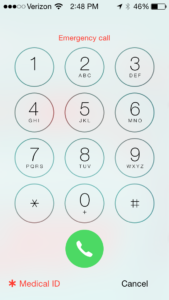Keeping Kids Safe: In Case of Emergency (ICE) and Apple Health App
I know I might sound a little crazy, but I sometimes wonder what would happen if one of my kids got hurt while on a bike or out running. Who would know who they are? How would I be contacted? As much as we, as parents, get frustrated with kids who always seem glued to their screens, there’s some advantages of having kids carrying a phone with them at all times.
One, of course, is that parents can contact their kids easily. And kids can contact parents if they need them. In fact, many teens have ICE (In Case of Emergency) contacts in their phone. So if they are hurt or unable to call, it’s easy to see who their emergency contact is. Many teens have ‘ICE’ next to their parents name in the contacts of the phone. Which makes sense, right? It seems like a great idea, a way to keep kids safe and enable anyone (whether it’s their friend, a paramedic, or another adult) to call a parent if their child is in trouble? Not so much.
A friend of mine has a nephew in college. One night, this young man got up at 2 a.m. to go to the bathroom. He walked out of his room and took a left turn, thinking he was heading for the bathroom. Unfortunately, the bathroom was on the right. He tumbled down the concrete basement stairs of the college campus house that he and his buddies were renting for the year.
When the friends asked the doctors and nurses, they said that they had no emergency contact information. The friends then realized that they did not have this young man’s parents’ phone numbers. Someone mentioned that he probably had ICE in his phone. The hospital personnel told them that they could not access the information because it was beyond the lock screen!
This story made me think of my own situation. I often ride a road bike for miles. I always have my phone tucked away on my bike, providing me piece of mind. However, if I were injured seriously, and unable to communicate, the phone would be utterly useless to any First Responder because of the lock screen.
As I spoke to parents about this, most responded quickly by telling me, “Oh, my child has me as his ICE contact.” However, as I questioned them on the conundrum of the lock screen, they would look at me, first with puzzlement, and then, with growing panic as it dawned on them how worthless ICE in contacts really is. What bothered me most is how overlooked this is. So I asked the question:
How can someone access emergency contact info on the phone of a person who’s unconscious or unable to unlock their phone?
The first and simplest answer is in the iPhone iOS 8.0 device. Every device comes with the Apple Health app preinstalled. Here is the icon displayed on the device:
The Apple Health app does everything from track your steps and exercise to track your nutrition, sleep and more. Here is an article with a information on the app itself .
While it has tons of functionality that I’m not interested in, it does contain what could possibly be life saving functionality for both me and my children. I can input an emergency contact (along with key medical data such as allergies, blood type, etc.) and that information can all be accessed without unlocking your phone. This feature is called Medical ID.
How to Set Up Medical ID
- Open the Health app and click “Medical ID” tab at the bottom of the screen. Input emergency contact (and any other relevant medical information) into the form.
- Edit the info to “show when locked” so that the ID can be seen when the screen is locked.
- To find this info on any phone, slide to open. You’ll see the keypad for a password, but on the lower left is the word “Emergency.” Tap that, and it gives you the option to speed-dial 911, or access Medical ID. Tap that, and you’re in.
While the information is available, someone has to know how to access it. The more people use this app and talk about it, the more awareness and use of this powerful tool will grow. Please do two things:
- Set this up on your child’s phone, and show them how it works. It’s a simple way to be sure your teens have you listed as their emergency contact, and that the information is accessible to anyone.
- Second, please pass this post along to a friend, or share it on your social media page. The more people know about and use this app, the safer our children will be.
For those Android users, there are similar apps in Google Play. While they are not factory installed as it is on the iOS device, there are downloadable apps in the Play store. Some are free, while others that offer greater functionality, have a small price.
Back to my friend’s nephew….his roommates, fortunately, heard the noise from him falling, and rushed out to find him at the bottom of the stairs. Sadly, he fractured his skull and had bleeding on the brain. His friends quickly called 911 and got him to the hospital, but his condition was dire. It was hours before his friends, sitting in the ER waiting room, realized that his parents had not been notified. Nobody wants to be that parent.




